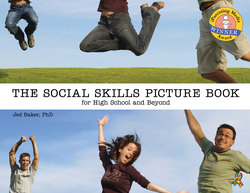Читать книгу The Social Skills Picture Book - Jed Baker - Страница 16
На сайте Литреса книга снята с продажи.
Оглавлениеxv
About Social Skills Picture Books
What Are Social Skills Picture Books?
The Social Skills Picture Books depict, step by step, teens demonstrating various social skills. The books are like cartoon strips,
yet they are composed of digital pictures of actual students combined with text and cartoon bubbles to denote what the students are
saying as they engage in the skills. The pictures show, for each step of a skill, the right way (and sometimes the wrong way) to act,
along with accompanying text that explains what to do.
As described earlier, the picture books attempt to compensate for the inherent difficulties many autistic individuals share. The
picture books make explicit what to do and say in social situations. In addition, by utilizing a picture format, they compensate for
language processing difficulties and distractibility, making abstract concepts more concrete and stable.
Reading the picture books is not a substitute for actually practicing the skills. The picture books are tools to use in the initial
acquisition of skills and should be followed with actual practice of the skills in the situations in which they are needed. If the goal is
for a student to demonstrate a skill in a particular situation, then ultimately the student will need to repeatedly practice that skill in that
situation. However, before students can physically practice a skill, they need some understanding of what to do. The picture books can
facilitate that initial understanding.
The reason one performs a skill is often because it achieves a desired outcome. The picture books help individuals visualize (a) the
positive outcomes of performing a skill and (b) how people think and feel in response to their behaviors.
Who Should Use Picture Books?
The picture books will benefit most “typical” students by engaging attention and breaking down abstract skills into more concrete
steps. It will be particularly helpful for those who have difficulties with auditory/language processing, abstract thinking, and sustaining
attention. This includes individuals on the autistic spectrum as well as those with Attention Deficit/Hyperactivity Disorders and/or
multiple learning disabilities.
How to Use the Picture Books
Using the picture books involves the four stages described below: (1) initial instruction, (2) role-playing the skill, (3) reviewing the
skill steps with corrective feedback, and (4) generalization. The first three stages can be repeated many times, such that one could
go back to stage 1 after stage 3. These stages are quite similar to the stages of “structured learning,” described by Goldstein and
